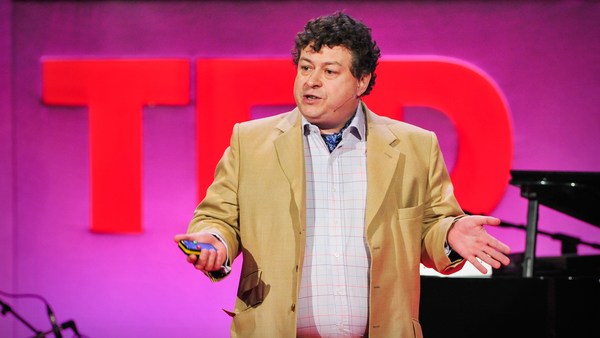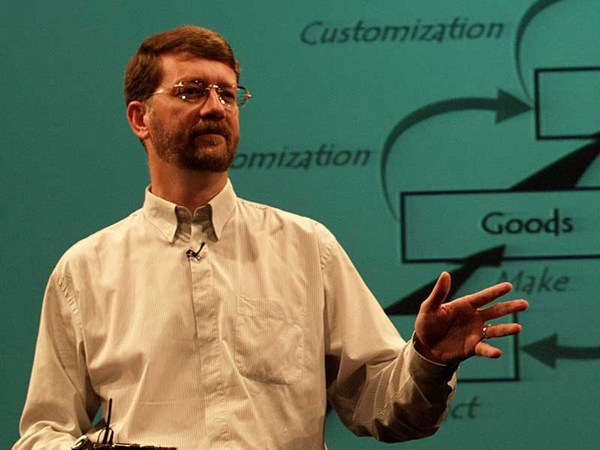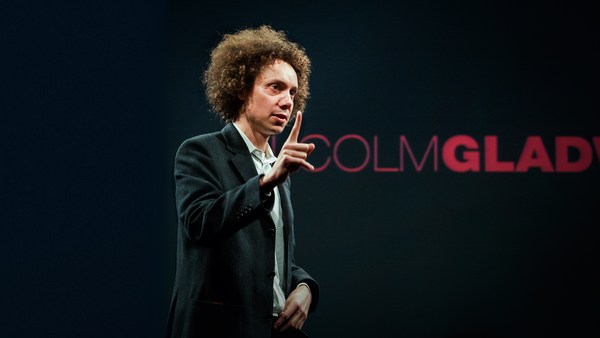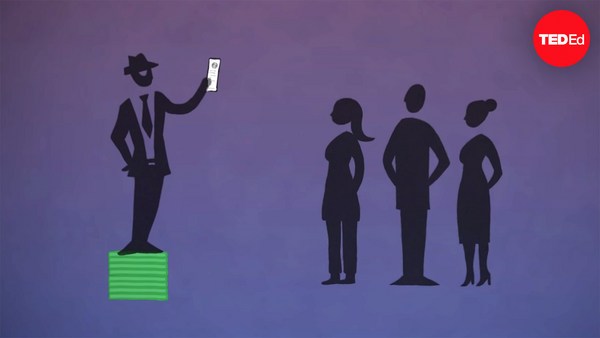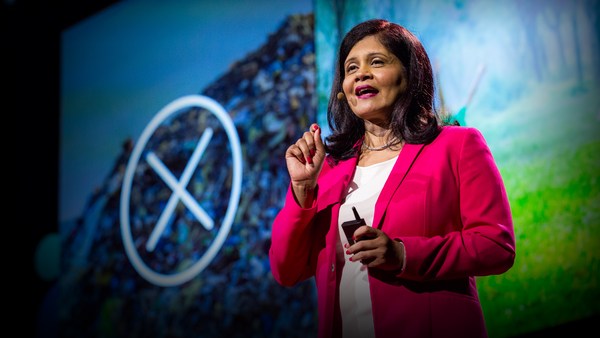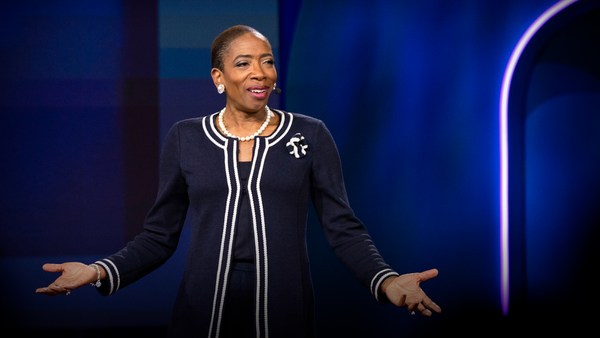Thirteen trillion dollars in wealth has evaporated over the course of the last two years. We've questioned the future of capitalism. We've questioned the financial industry. We've looked at our government oversight. We've questioned where we're going. And yet, at the same time, this very well may be a seminal moment in American history, an opportunity for the consumer to actually take control and guide us to a new trajectory in America.
I'm calling this The Great Unwind.
(Laughter)
And the idea is a simple, simple idea, which is the fact that the consumer has moved from a state of anxiety to action. Consumers who represent 72 percent of the GDP of America have actually started, just like banks and just like businesses, to de-leverage, to unwind their leverage in daily life, to remove themselves from the liability and risk that presents itself as they move forward.
So, to understand this -- and I'm going to stress this -- it's not about the consumer being in retreat. The consumer is empowered. To understand this, we'll step back and look at what's happened over the last year and a half. So if you've been gone, this is the CliffsNotes on what's happened in the economy.
(Laughter)
Unemployment up. Housing values down. Equity markets down. Commodity prices are like this.
If you're a mom trying to manage a budget, and oil was 150 dollars a barrel last summer, and it's somewhere between 50 and 70, do you plan vacations? How do you buy? What's your strategy in your household? Will the bailout work? We have national debt, Detroit, currency valuations, health care -- all these issues facing us. You put them all together, mix them up in a bouillabaisse, and you have consumer confidence that's basically a ticking time bomb.
In fact, let's go back and look at what caused this crisis, because the consumer, all of us, in our daily lives, actually contributed a large part to the problem. This is something I call the 50-20 paradox. It took us 50 years to reach annual savings ratings of almost 10 percent. Fifty years. Do you know what this was right here? This was World War II. Do you know why savings was so high? There was nothing to buy, unless you wanted to buy some rivets.
What happened, though, over the course of the last 20 years, we went from a 10 percent savings rate to a negative savings rate. Because we binged. We bought extra-large cars, supersized everything, we bought remedies for restless leg syndrome. All these things together basically created a factor where the consumer drove us headlong into the crisis that we face today. The personal debt-to-income ratio basically went from 65 to 135 percent in the span of about 15 years. So consumers got over-leveraged. And of course our banks did as well, as did our federal government.
This is an absolutely staggering chart. It shows leverage, trended out from 1919 to 2009. And what you end up seeing is the whole phenomenon that we are actually stepping forth and basically leveraging future education, future children in our households.
So if you look at this in the context of visualizing the bailout, what you can see is, if you stack up dollar bills, first of all, 360,000 dollars is about the size of a five-foot-four guy. But if you stack it up, you see this amazing, staggering amount of dollars that have been put into the system to fund and bail us out. So this is the first 315 billion. But I read this fact the other day, that one trillion seconds equals 32,000 years. So if you think about that, the context, the casualness with which we talk about trillion-dollar bailout here and trillion there, we are stacking ourselves up for long-term leverage.
However, consumers have moved. They are taking responsibility. What we're seeing is an uptake in the savings rate. In fact, 11 straight months of savings have happened since the beginning of the crisis. We're working our way back up to that 10 percent. Also, remarkably, in the fourth quarter, spending dropped to its lowest level in 62 years -- almost a 3.7 percent decline.
Visa now reports that more people are using debit cards than credit cards. So we're starting to pay for things with money that we have. And we're starting to be much more careful about how we save and invest. But that's not really the whole story, because this has also been a dramatic time of transformation. And you've got to admit, over the last year and a half, consumers have been doing some weird things. It's pretty staggering, what we've lived through. If you take into account that 80 percent of all Americans were born after World War II, this was essentially our Depression.
And so, as a result, some crazy things have happened. I'll give you some examples. Let's talk about dentists, vasectomies, guns and shark attacks.
(Laughter)
Dentists report molars -- people grinding their teeth, coming in and reporting that they've had stress. So there's an increase in people having to have their fillings replaced. Gun sales, according to the FBI, who does background checks, are up almost 25 percent since January. Vasectomies are up 48 percent, according to the Cornell Institute. And lastly, but a very good point, hopefully not related to the former point I just made, which is that shark attacks are at their lowest level from 2003. Does anybody know why?
(Laughter)
No one's at the beach. So there's a bright side to everything.
But seriously, what we see happening, and the reason I want to stress that the consumer is not in retreat, is that this is a tremendous opportunity for the consumer who drove us into this recession to lead us right back out. What I mean by that is we can move from mindless consumption to mindful consumption. Right?
(Applause)
If you think about the last three decades, the consumer has moved from savvy about marketing in the '90s, to gathering all these amazing social and search tools in this decade. But the one thing holding them back is the ability to discriminate. By restricting their demand, consumers can actually align their values with their spending, and drive capitalism and business to not just be about more, but to be about better.
We're going to explain that right now. Based on Y&R's BrandAsset Valuator, proprietary tool of VML and Young & Rubicam, we set out to understand what's been happening in the crisis with the consumer marketplace. We found a couple of really interesting things. We're going to go through four value shifts that we see driving new consumer behaviors, that offer new management principles.
The first cultural value shift we see is this tendency toward something we call "liquid life." This is the movement from Americans defining their success on having things to having liquidity, because the less excess that you have around you, the more nimble and fleet of foot you are. As a result, déclassé consumption is in. Déclassé consumption is the whole idea that spending money frivolously makes you look a little bit anti-fashion. The management principle is dollars and cents.
So let's look at some examples of this déclassé consumption that falls out of this value. The first thing is, something must be happening when P. Diddy vows to tone down his bling.
(Laughter)
But seriously, we also have this phenomenon on Madison Avenue and in other places, where people are actually walking out of luxury boutiques with ordinary, generic paper bags to hide the brand purchases. We see high-end haggling in fashion today, high-end haggling for luxury and real estate. We also see just a relaxing of ego, and sort of a dismantling of artifice.
This is a story on the yacht club that's all basically blue collar. Blue-collar yacht club -- where you can join, but you've got to work in the boatyard as condition of membership. We also see the trend toward tourism that's a little bit more low-key: agritourism -- going to vineyards and going to farms.
And then we also see this movement forward from dollars and cents. What businesses can do to connect with these new mindsets is really interesting. A couple things that are kind of cool. One is that Frito-Lay figured out this liquidity thing with their consumer. They found their consumer had more money at the beginning of the month, less at the end of the month. So they started to change their packaging: larger packs at the beginning of the month, smaller packaging at the end of the month.
Really interestingly, too, was the San Francisco Giants. They've just instituted dynamic pricing. It takes into account everything from the pitcher match-ups, to the weather, to the team records, in setting prices for the consumer. Another quick example of these types of movements is the rise of Zynga. Zynga has risen on the consumer's desire to not want to be locked in to fixed cost. Again, this theme is about variable cost, variable living. So micro-payments have become huge. And lastly, some people are using Hulu as a device to get rid of their cable bill. So, really clever ideas there that are being taken ahold of and that marketers are starting to understand.
The second of the four values is this movement toward ethics and fair play. We see that play itself out with empathy and respect. The consumer is demanding it. And, as a result, businesses must provide not only value, but values. Increasingly, consumers are looking at the culture of the company, at their conduct in the marketplace. So we see with empathy and respect lots of really hopeful things come out of this recession. I'll give you a few examples.
One is the rise toward communities and neighborhoods, and increased emphasis on your neighbors as your support system. Also, a wonderful by-product of a really lousy thing, which has been unemployment, is a rise in volunteerism that's been noted in our country. We also see the phenomenon -- some of you may have "boomerang kids" -- these are "boomerang alumni," where universities are actually reconnecting with alumni and helping them with jobs, sharing skills and retraining. We also talked about character and professionalism. We had this miracle on the Hudson in New York City in January, and suddenly Sully has become a key name on BabyCenter.
(Laughter)
So, from a value and values standpoint, what companies can do is connect in lots of different ways. Microsoft is doing something wonderful. They are actually vowing to retrain two million Americans with IT training, using their existing infrastructure to do something good.
Also, a really interesting company is GORE-TEX. GORE-TEX is all about personal accountability of their management and their employees, to the point where they really kind of shun the idea of bosses. But they also talk about the fact that their executives -- all of their expense reports are put onto their company intranet for everyone to see. Complete transparency. Think twice before you have that bottle of wine.
(Laughter)
The third of the four laws of post-crisis consumerism is about durable living. We're seeing in our data that consumers are realizing this is a marathon, not a sprint. They're digging in and looking for ways to extract value out of every purchase they make. Witness the fact that Americans are holding on to their cars longer than ever before: 9.4 years on average, in March. A record. We also see the fact that libraries have become a huge resource for America. Did you know that 68 percent of Americans now carry a library card? The highest percentage ever in our nation's history.
So what you see in this trend is also the accumulation of knowledge. Continuing education is up. Everything is focused on betterment, training, development and moving forward. We also see a big DIY movement. I was fascinated to learn that 30 percent of all homes in America are actually built by owners. That includes cottages and the like, but 30 percent. People are getting their hands dirty, rolling up their sleeves. They want these skills.
We see it with the phenomenon of raising backyard hens, chickens and ducks. And when you work out the math, they say it doesn't work, but the principle is there; it's about being sustainable and taking care of yourself. Then we look at the High Line in New York City, an excellent use of reimagining existing infrastructure for something good, which is a brand-new park in New York City.
So what brands can do, and companies, is pay dividends to consumers, be a brand that lasts, offer transparency, promise you're going to be there beyond today's sale. Perfect example of that is Patagonia. Patagonia's "Footprint Chronicles" basically goes through and tracks every product they make, and gives you social responsibility, and helps you understand the ethics behind the product they make.
Another great example is Fidelity. Rather than instant cash-back rewards on your credit or debit purchases, this is about 529 rewards for your student education. Or the interesting company Sunrun. I love this company. They've created a consumer collective where they put solar panels on households and create a consumer-based utility, where the electricity they generate is basically pumped back out into the marketplace. So it's a consumer-driven co-op.
The fourth post-crisis consumerism that we see is this movement about "return to the fold." It's incredibly important right now. Trust is not parceled out, as we all know. It's now about connecting to your communities, connecting to your social networks. In my book, I talked about the fact that 72 percent of people trust what other people say about a brand or a company, versus 15 percent on advertising. So in that respect, cooperative consumerism has really taken off. This is about consumers working together to get what they want out of the marketplace. Let's look at a couple of quick examples.
The artisanal movement is huge: everything about locally derived products and services, supporting your local neighborhoods, whether it's cheeses, wines and other products. Also this rise of local currencies. Realizing that it's difficult to get loans in this environment, you're doing business with people you trust in your local markets. So this rise of local currency is another really interesting phenomenon. And then they did a recent report I thought was fascinating. They actually started, in certain communities in the United States, to publish people's electricity usage. And what they found out is when that was available for public record, the people's electricity usage in those communities dropped.
Then we also look at the idea of cow-pooling, which is the whole phenomenon of consumers organizing together to buy meat from organic farms, that they know is safe and controlled in the way that they want it to be controlled. And then there's this other really interesting movement in California, which is about carrot mobs. The traditional thing would be to boycott, right? Have a stick. Well, why not have a carrot? So these are consumers organizing, pooling their resources to incentify companies to do good.
And then we look at what companies can do. This is all the opportunity about being a community organizer. You have to realize that you can't fight and control this. You actually need to organize it. You need to harness it. You need to give it meaning. And there's lots of really interesting examples here. First is just the rise of the fact that Zagat's has actually moved out of and diversified from rating restaurants, into actually rating health care. So what credentials does Zagat's have? Well, they have a lot, because it's their network of people. So that becomes a very powerful force for them to make their brand more elastic.
Then you look at the phenomenon of Kogi. This Kogi doesn't exist. It's a moving truck. It's a moving truck through L.A., and the only way you can find it is through Twitter.
(Laughter)
Or you look at Johnson & Johnson's "Momversations," a phenomenal blog that's been built up, where J&J basically is tapping into the power of mommy bloggers, allowing them to create a forum where they can communicate and connect. And it's also become a very valuable advertising revenue for J&J as well. This, plus the fact that you've got phenomenal work from CEOs, from Ford to Zappos, connecting on Twitter, creating an open environment, allowing their employees to be part of the process, rather than hidden behind walls.
You see this rising force in total transparency and openness that companies are starting to adopt, all because the consumer is demanding it. So when we look at this and step back, what I believe is that the crisis that exists today is definitely real. It's been tremendously powerful for consumers. But at the same time, this is also a tremendous opportunity. The Chinese character for crisis is actually the same side of the same coin. Crisis equals opportunity. What we're seeing with consumers right now is the ability for them to actually lead us forward out of this recession.
So we believe that values-driven spending will force capitalism to be better: it will drive innovation; it will make longer-lasting products; it will create better, more intuitive customer service; and it will give us the opportunity to connect with companies that share the values that we share. So when we look back and step out at this and see the beginning of these trends that we're seeing in our data, we see a very hopeful picture for the future of America.
Thank you very much.
(Applause)
